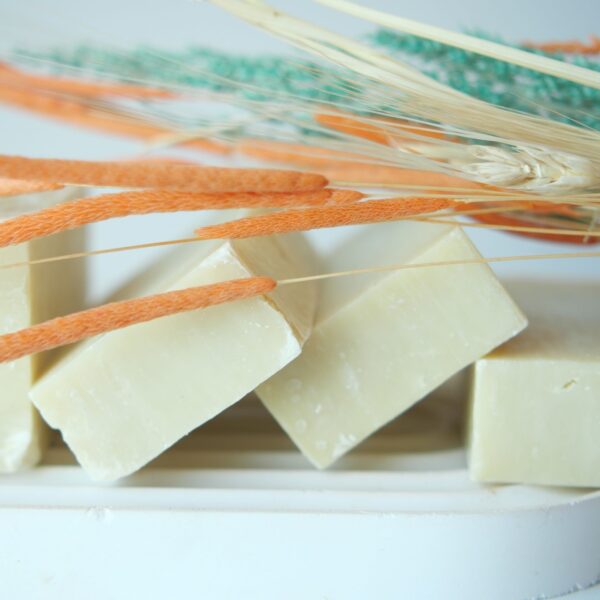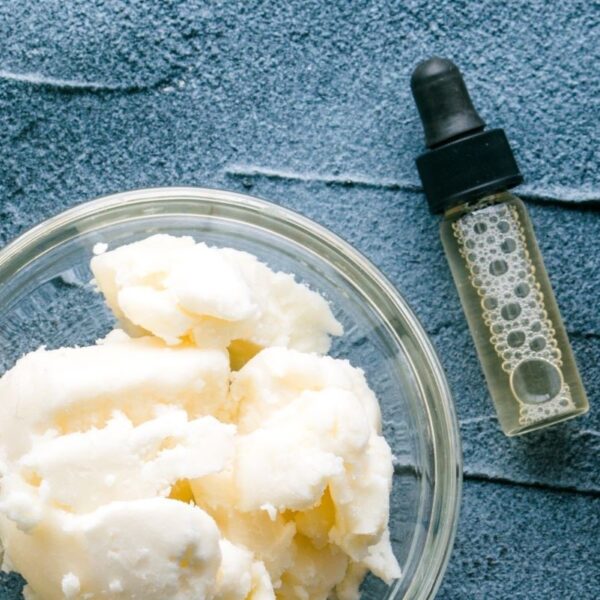Guar gum, a naturally derived polysaccharide extracted from the seeds of the guar plant, is a colorless, odorless, and free-flowing powder with a unique blend of galactose and mannose sugars. Its neutral chemical composition and versatility make it a sought-after ingredient in the cosmetics and personal care industry. With its natural origins and functional benefits, guar gum is a valuable additive that aligns with the growing demand for natural and sustainable beauty solutions.
What is Guar Gum?
Guar gum is a complex carbohydrate comprising mannose and galactose molecules connected by glycosidic bonds. Its molecular weight varies from 200,000 to 2,000,000 Daltons, depending on how it is processed.
Source: Wikipedia
Mannose forms the polymer’s backbone, linked together by β (1→4) glycosidic bonds. Galactose forms branches onto the mannose backbone through α (1→6) glycosidic bonds. The mannose-to-galactose ratio of guar gum has been reported to be approximately 2:1. The molecular weight of guar gum can range between 1-2 million Da. Due to the strong hydrogen bonding and the extensive intertwining of molecules, guar gum can form highly viscous solutions when mixed with water.
How is Guar Gum Produced?
Guar gum is derived from the seeds of the guar plant through a series of steps. First, the seeds are dried and then mechanically dehusked to separate the outer shell from the endosperm. The endosperm is then ground and mixed with water to create a slurry, which undergoes purification and gum precipitation. Finally, the guar gum is dried and finely powdered for various applications.
Use of Guar Gum in Personal Care Products
Guar gum is a key component in various beauty formulations, such as moisturizers, serums, masks, and hair care products, due to its ability to improve texture and stability. Its properties make it popular among consumers looking for gentle yet effective products.
Applications in Personal Care
| Function | Applications |
| Binder | Guar gum acts as a binding agent in cosmetics, helping to hold the ingredients together and providing a smooth and consistent texture to the product. |
| Viscosity Modifier | Guar gum controls the viscosity of cosmetic formulations, helping to improve the spreadability and texture of the product for better application and absorption. |
| Stabilizer | Guar gum stabilizes emulsions in cosmetics by preventing the separation of oil and water phases, ensuring a uniform and stable product. |
| Film Forming Agent | Guar gum forms a thin film on the skin or hair surface, providing a protective barrier against environmental stressors and helping to retain moisture. |
Product Examples
| Type | Examples |
| Skincare | Moisturizers, serums, face masks, eye cream, eye serums |
| Hair Care | Shampoos, conditioners, styling gels |
| Makeup | Foundations, concealers, lipstick |
| Sun Care | Sunscreen, after-sun products |
Properties of Guar Gum
| Physical Form | Powder |
| Color | Yellow to white |
| Odor | Odorless |
| Storage Temperature & Conditions | Ambient conditions away from moisture |
| Molecular Weight | Variable, 50,000-–8,000,000 |
| Appearance | Free-flowing powder |
| pH | 6.5-7.5 |
| Density @ 25°C | 0.8-1.0 g/mL |
| Viscosity (1%, H2O, 20℃) | 350 to 700 mPa-s |
| Gelling Temperature | 25-40°C |
| Melting Point | >220°C |
| Solubility | Highly soluble in water |
| Claims (*Product Specific) | Natural*, Halal*, Kosher*, Non-GMO, Vegan, Plant-based, No added sugar |
Typical Formulations
Toothpaste
Here is an example of a toothpaste formulation table along with the % weight of ingredients:
| Ingredient | % Composition |
| Sorbitol (70wt% Aqueous solution) | 21 |
| Guar gum | 0.1 |
| Sodium saccharin | 0.27 |
| Sodium monofluorophosphate | 1.1 |
| CMC | 1 |
| Sodium bicarbonate | 0.1 |
| Sodium carbonate | 0.4 |
| Silica | 2 |
| Calcium carbonate | 42 |
| Titanium dioxide | 0.1 |
| Sodium la | 2 |
| Methylparaben | 0.1 |
| Propylparaben | 0.02 |
| Deionized water | 28.8033 |
| Flavor | 1 |
| CI Pigment Green 7 | 0.0067 |
Source: Google Patents
Shampoo
Here is an example of a shampoo formulation table along with the % weight of ingredients:
| Ingredient | % Composition |
| Extract of Sapindus Mukorossi | 10 |
| Betaine | 2 |
| Sorbitol | 5 |
| Gum Arabic | 1 |
| Konjac gum | 0.375 |
| Guar gum | 0.375 |
| Whey protein | 1 |
| Water | 58.25 |
Source: EPO
Guar Gum Formulation Considerations
| Physical Forms | Powder |
| Stability | pH: StableTemperature: Degraded around 300 °C; However, the temperature stability is drastically reduced in low pH conditions. |
| Sensory Attributes | Odorless, with a slightly bitter taste |
| Dosage | 0.5-2.0, depending on the application |
Rheological Properties
Guar gum can swell or dissolve in a polar solvent by forming strong hydrogen bonds. In nonpolar solvents, guar gum only forms weak hydrogen bonds. It creates a thick colloidal dispersion that exhibits thixotropic rheological behavior when fully hydrated. Thixotropy refers to the decrease in resistance as the shear rate increases. Dilute solutions are less thixotropic but become more thixotropic as the concentration increases.
Guar gum displays shear thinning behavior, meaning its viscosity decreases as the shear rate or stress increases. Once the shear force is removed, guar gum returns to its original viscosity. Aqueous solutions of guar gum do not exhibit yield stress properties.
Factors Affecting the Rheological Properties of Guar Gum
| Property | Effect |
| Particle Size & Shape | – In a study, particles’ shape and size significantly impacted guar gum’s hydration. – In another study, increased particle size caused a decrease in apparent viscosity and increased the flow index of guar gum samples. |
| Chain Length (Molecular Weight) | – The shear thinning behavior of guar gum increases with molecular weight. – The intrinsic viscosity of guar gum is directly correlated to the molecular weight. |
| Treatments | – In a study, micronization caused significant disruption to the microstructure of guar gum, resulting in a rough surface and a drastic reduction in viscosity. Another study revealed that sonication led to changes in rheological properties, transitioning into Newtonian flow behavior, potentially due to irreversible pyrolysis of hydrocolloid dispersions. Radiation, as a dry technique for depolymerization, can reduce the viscosity of guar gum solution by up to 10000 folds. |
| Concentration | – Doubling the concentration of guar gum in a solution leads to a tenfold increase in viscosity. Inter-molecular chain interaction or entanglement increases with concentration, leading to increased viscosity. – A low concentration of guar gum solutions shows Newtonian flow behavior. At concentrations over 0.5%, this changes to non-Newtonian and thixotropic behavior. Pseudoplastic flow behavior is reported in aqueous solutions containing 0.5%-1.5% guar gum. At 1% concentration, the guar gum solutions show typical behavior of macromolecular biopolymer with dominating loss modulus (G″) over storage modulus (G′) in the lower frequency range. |
| pH | – Guar gum, being non-ionic, makes stable solutions over a wide pH range of about 1.0-10.5 in ambient conditions. – At higher temperatures (>50 °C), the acid hydrolysis of guar gum has been reported to be more prominent. In a study, the decrease in viscosity due to increased temperature was more prominent (4-23%) in highly acidic conditions (pH 1-3). – The rate of hydration is also affected by the pH. |
| Temperature | – A study revealed that, at a constant shear rate, the viscosity of a 1% guar gum solution decreased with an increase in temperature. Also, at an increasing shear rate, the decrease in viscosity was accelerated by temperature rise. Temperature rise induced kinetic movement, leading to more vibrations and thus loosening of the intermolecular forces, causing rapid viscosity decrease. |
| Modification | – Substitution alters the flow properties of polymers in important and unexpected ways. Some of the characteristics are given below. |
Modified Guar Gum
In a study, substituting a hydrophobic hydroxypropyl group on guar gum decreased the zero-shear rate value and relaxation time compared to native guar gum. In contrast, for hydrophilic substitution with a sodium carboxymethyl group, the viscosity is higher at lower concentrations than native guar gum. This could be due to the electroviscous effect of polyelectrolytes. Similarly, hydroxyethyl guar gum has been shown to have lower viscosities compared to native guar gum.
In a study, the addition of hydrophobic unsaturated long chains gave oleic guar gum (OGG), linoleic guar gum (LGG), and erucic guar gum (EGG). They showed more robust shear thinning properties at a concentration of 1% compared to native guar gum. The molar substitution ratio for these groups also affects the rheological properties.
Guar Gum’s Effect on Properties of Personal Care Products
| Property | Effect |
| Consistency | Guar gum is a natural thickening agent that helps increase cosmetic formulations’ viscosity. |
| Stability | Guar gum is known for its ability to enhance the stability of cosmetic formulations. It helps prevent phase separation, syneresis, and sedimentation by forming a network that holds the ingredients together. This can help extend the product’s shelf life and maintain its efficacy over time. Guar gum also helps improve the emulsion stability in formulations, making them less prone to breaking or separating. |
| Sensory Properties | Guar gum can help improve the product’s texture, making it smoother, silkier, and more luxurious. It also has emollient properties. |
| Spreadability | Guar gum can help enhance the spreadability and absorption of cosmetic products, ensuring they are easily absorbed into the skin without leaving a greasy or sticky residue. |
Safety and Regulatory Considerations
| FDA Information | Guar gum is the natural substance obtained from the maceration of the seed of the guar plant and is “generally regarded as safe” (GRAS) as per the US FDA. |
| EU Information | The EU Cosmetics Inventory lists guar gum as a permitted food additive. |
| Cosmetic Ingredient Review (CIR) Information | CIR has assessed the safety of guar gum in personal care applications and found it to be safe. |
Safety & Toxicity of Guar Gum
The CIR Expert Panel reviewed data that indicated guar gum was not genotoxic, carcinogenic, or a developmental toxicant. Guar Gum and its derivatives were also not dermal irritants or sensitizers. Based on the available data, the CIR Expert Panel concluded that guar gum was safe for cosmetic and personal care products.
Identification Numbers
| CAS Number | 9000-30-0 |
| EC Number | 232-536-8 |
| INCI Name | CYAMOPSIS TETRAGONOLOBA GUM |
| EIENCS Number | 232-536-0 |
Fun Facts About Guar Gum
- Guar gum has been used for centuries in India as a thickening agent in traditional foods such as curries, gravies, and desserts.
- Due to its excellent thickening, stabilizing, and binding properties, Guar gum has various applications beyond the cosmetics industry, including in food, pharmaceuticals, and textiles.
Additional Resources
Bibliography
- Handbook of Food Proteins – ScienceDirect
- Re-evaluation of guar gum (E 412) as a food additive – ResearchGate
- Guar: agronomy, production, industrial use, and nutrition – Google Scholar
- Carbohydrate Polymers – ScienceDirect
- Drug Development and Industrial Pharmacy – Taylor & Francis Online
- IAEA – Physio-Chemical Study of Guar Gum
- IOP Conference Series: Materials Science and Engineering – IOPscience
- International Journal of Food Sciences and Nutrition – Taylor & Francis Online
- Certain Rheological Aspects of Functionalized Guar Gum – ResearchGate
- Food Technology – Google Scholar
- Journal of the Academy of Nutrition and Dietetics – PubMed Central (PMC)
- Food Hydrocolloids – ScienceDirect
- Studies in Rheological Behaviour of Guar Gum Solution – TSI Journals
- Journal of Applied Polymer Science – Wiley Online Library
- Journal of Food Engineering – ScienceDirect
- RSC Advances
- Food Chemistry – ScienceDirect
- Guar Gum in Cosmetic Formulation: Best Practices & Applications – Altrafine Gums
- Safety Assessment of Galactomannans
- Safety Assessment of Galactomannans








